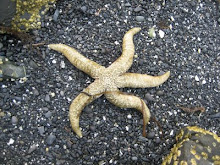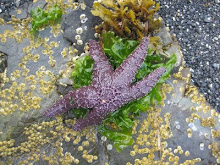Any idea what this is? It is a large Coastal Brown Bear swimming toward the far shore. After studying the charts, I estimated that the Bear was about 3/4 of a mile from the shore toward which he was swimming, and 3/4 of a mile from the shore where he had entered the water. The passengers on the tour boat I was captaining were amazed at the swimming ability of the bear. Fact: Bears that live on islands swim well. This photo was taken in Sitka Sound
between Gragarin Island and Krestof Island. When we came upon swimming bear we were always careful to stay a safe distance as stories circulated about commercial fishing vessels that would get so close that the bear would decide to climb aboard for a little rest. Definitely not something you would want to share deck space with.
A couple of years later, I came upon a bear in about the same area but he was swimming from Gragarin Island to Kruzof Island. He was only a couple of hundred yards off of Gragarin. We hoped that he would abort and go back to Gragarin because the distance to Kruzof was more like three or four miles. With our gentle persuasion by cutting him off out at a safe distance, he finally turned and swam back to Gragarin.
Coastal Brown Bears can run 35 miles an hour. You would never want to try to out-run a Bear. Although they don't swim really fast, you would still not want to try to out-swim a bear. In the short run you may be able to swim faster, but in the long run he would out endure you.
This is a swimming Sitka Black-tail Deer. During the tour season between May and September, I would usually see a swimming Deer about once a month. The area around Sitka, Alaska is an Ocean-Island world.
One day on the way to Juneau from Sitka, I came upon two young deer swimming from Deadman Reach in Peril Straight out to the area of Hoggup Reef. I got too close and the Deer started swimming for the Catamaran. I backed off quickly and the Deer started back for Deadman's Reach area. It was heart wrenching to see those two little Deer swimming their hearts out in that frigid sea. I didn't have time to wait to see if they made it back to shore safely, but I'm sure they did. I hope so!
Another time, I came across a large buck drown and floating in the sound. I'm sure that the Deer tried to swim between two islands and got caught in an outgoing tide. As the current took him out further and further in the sound, he got colder and colder and exhaustion finally won out. That Deer had probably swam between those islands many times, but finally, a series of unfortunate events.
One thing that was always interesting was that when the deer I was watching finally arrived at the shore and climbed out of the water, it would always stop and turn and look at us. Then it would take a short time to rejuvenate from the cold swim before it would shake off the water like a dog, and then slowly walk back into the trees.
It was always spectacular to see mammals swimming in the ocean in Alaska.
I never got any photos of this next story, but one day in Jamestown Bay, I saw a mother Merganser swimming across the bay with about 10 little baby Mergansers on her back. She was swimming like crazy and she kept looking behind her as she swam and it dawned on me why. A Bald Eagle saw an easy meal of Merganser chicks. As the Eagle would swoop down, she would give the signal and all of the chicks would jump off of her back and into the water and under her. She would turn and face the Eagle as he flew by and quake and flap her wings but there was never anything for him to grab in his talons. As soon as the Eagle would pass, her little chicks would pop back up to the surface and jump back on their mamma's back, and she would take off swimming again. It was so interesting watching that hen Merganser fighting for the lives of her little chicks. From the shore, we were cheering every time the Eagle would come away empty handed. Of course there was absolutely nothing we could do for the Merganser family.
One day I saw a Bald Eagle dive into the sea after a spanning Salmon and pop back to the surface with a Cormorant in his talons. When Eagle catch heavy objects in the water they swim to the shore with their catch. The Cormorant was still alive and it flapped and fought all the way to he shore. When the Eagle arrived at the shore he took one bite at the Cormorant and seemed to say, "yuck", and abandoned the Cormorant. Of course the Cormorant wasn't in very good shape because of the tight grip of the Eagle's talons. As it laid there on the shore other Eagles took a taste of the easy meal but also quickly lost interest. Oily Cormorant just doesn't compare with savory salmon. No such thing as a free meal.
Cormorants somewhere in Sitka Sound
An Eagle waiting and watching for a meal in Nakwasina Sound.
Here is a photo that Denalee took of a Coastal Brown Bear from a boat. Bears love to eat the beach grass in the spring before the berries are ripe and the salmon start spanning. Could he be contemplating a swim to another island. "but the water is sooo cold, do I really want to swim to another island?" This a younger Bear but still weights probably 600 to 800 pounds.
































